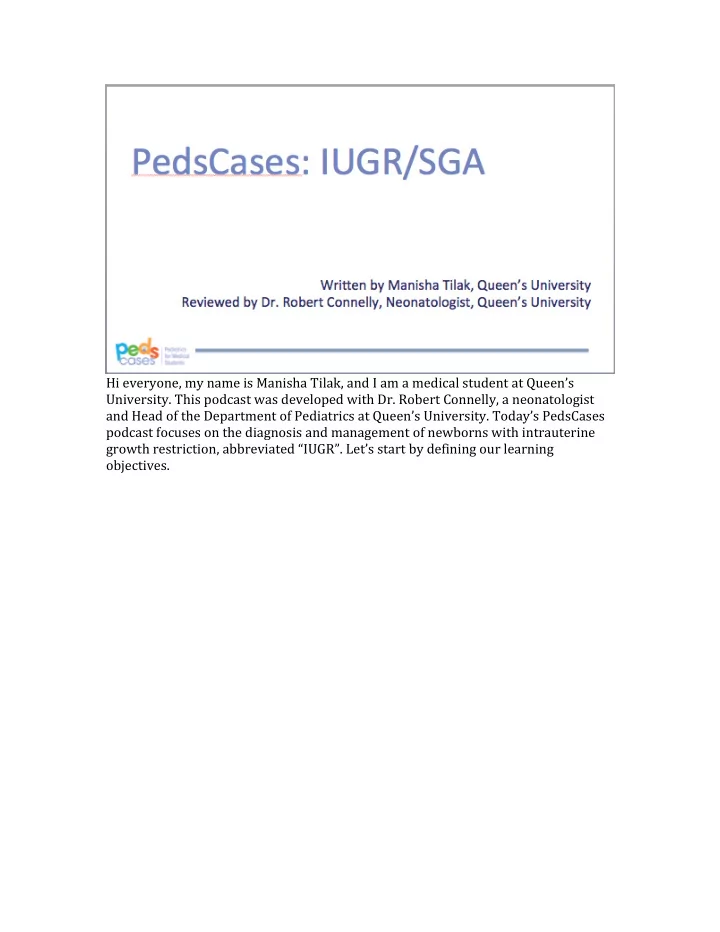

¡ Hi ¡everyone, ¡my ¡name ¡is ¡Manisha ¡Tilak, ¡and ¡I ¡am ¡a ¡medical ¡student ¡at ¡Queen’s ¡ University. ¡This ¡podcast ¡was ¡developed ¡with ¡Dr. ¡Robert ¡Connelly, ¡a ¡neonatologist ¡ and ¡Head ¡of ¡the ¡Department ¡of ¡Pediatrics ¡at ¡Queen’s ¡University. ¡Today’s ¡PedsCases ¡ podcast ¡focuses ¡on ¡the ¡diagnosis ¡and ¡management ¡of ¡newborns ¡with ¡intrauterine ¡ growth ¡restriction, ¡abbreviated ¡“IUGR”. ¡Let’s ¡start ¡by ¡defining ¡our ¡learning ¡ objectives. ¡ ¡ ¡ ¡ ¡ ¡ ¡ ¡ ¡ ¡
¡ After ¡this ¡PedsCases ¡podcast, ¡the ¡learner ¡should ¡be ¡able ¡to: ¡ 1. Define ¡intrauterine ¡growth ¡restriction, ¡and ¡differentiate ¡between ¡this ¡ condition ¡and ¡babies ¡who ¡are ¡small ¡for ¡gestational ¡age ¡ 2. List ¡maternal, ¡fetal, ¡and ¡placental ¡risk ¡factors ¡for ¡IUGR ¡ 3. Describe ¡the ¡appropriate ¡screening ¡and ¡workup ¡of ¡expectant ¡mothers ¡for ¡ IUGR ¡ 4. Describe ¡the ¡appropriate ¡post-‑natal ¡assessment ¡and ¡care ¡of ¡a ¡fetus ¡with ¡ IUGR ¡ 5. List ¡the ¡short-‑term ¡and ¡long-‑term ¡complications ¡of ¡IUGR ¡ ¡ ¡ ¡ ¡
¡ Let’s ¡start ¡with ¡a ¡clinical ¡case. ¡You ¡are ¡a ¡medical ¡student ¡working ¡with ¡the ¡neonatal ¡ intensive ¡care, ¡or ¡NICU ¡team ¡when ¡you ¡are ¡called ¡to ¡attend ¡a ¡delivery. ¡The ¡mother ¡is ¡ a ¡32 ¡year ¡old ¡gravida ¡3 ¡para ¡2 ¡with ¡two ¡previous ¡babies ¡who ¡had ¡birth ¡weights ¡ under ¡the ¡10 th ¡percentile. ¡This ¡baby ¡is ¡at ¡34 ¡weeks ¡gestation ¡and ¡has ¡an ¡estimated ¡ fetal ¡weight ¡at ¡the ¡5th ¡percentile ¡on ¡the ¡most ¡recent ¡antenatal ¡ultrasound. ¡Once ¡the ¡ baby ¡is ¡born ¡the ¡nurse ¡rapidly ¡hands ¡him ¡off ¡to ¡you ¡to ¡bring ¡to ¡the ¡neonatal ¡ resuscitation ¡bed. ¡What ¡are ¡your ¡immediate ¡and ¡long-‑term ¡management ¡plans ¡for ¡ this ¡newborn? ¡What ¡do ¡you ¡expect ¡to ¡find ¡on ¡physical ¡exam? ¡We’ll ¡come ¡back ¡to ¡this ¡ case ¡and ¡answer ¡these ¡questions ¡as ¡we ¡go ¡through ¡the ¡podcast. ¡ ¡ ¡ ¡ ¡
¡ So, ¡what ¡is ¡intrauterine ¡growth ¡restriction, ¡and ¡how ¡does ¡it ¡differ ¡from ¡babies ¡who ¡ are ¡small ¡for ¡gestational ¡age? ¡Both ¡IUGR ¡and ¡SGA ¡babies ¡are ¡small, ¡with ¡weights ¡that ¡ fall ¡below ¡the ¡10th ¡percentile ¡for ¡all ¡babies ¡of ¡the ¡same ¡gestational ¡age. ¡The ¡ difference ¡is ¡that ¡IUGR ¡babies ¡have ¡had ¡their ¡growth ¡restricted ¡in ¡utero ¡due ¡to ¡ maternal, ¡fetal ¡or ¡placental ¡pathology. ¡SGA ¡babies ¡on ¡the ¡other ¡hand ¡are ¡just ¡born ¡ small, ¡without ¡any ¡underlying ¡known ¡pathological ¡maternal, ¡fetal ¡or ¡placental ¡cause. ¡ Physicians ¡distinguish ¡between ¡the ¡two ¡by ¡using ¡a ¡variety ¡of ¡investigations ¡to ¡rule ¡ out ¡causes ¡of ¡IUGR, ¡which ¡we’ll ¡discuss ¡a ¡little ¡later ¡in ¡this ¡podcast. ¡If ¡the ¡baby’s ¡ small ¡size ¡can ¡be ¡attributed ¡to ¡a ¡pathological ¡cause ¡found ¡on ¡investigation, ¡IUGR ¡can ¡ be ¡diagnosed. ¡If ¡no ¡pathological ¡cause ¡can ¡be ¡found ¡on ¡investigation, ¡the ¡baby ¡is ¡ classified ¡as ¡SGA. ¡For ¡the ¡remainder ¡of ¡this ¡podcast, ¡we’re ¡going ¡to ¡focus ¡on ¡babies ¡ who ¡have ¡been ¡diagnosed ¡with ¡IUGR. ¡ ¡ ¡
¡ IUGR ¡is ¡usually ¡diagnosed ¡during ¡pregnancy, ¡but ¡can ¡be ¡diagnosed ¡after ¡birth ¡as ¡ well. ¡During ¡pregnancy, ¡antenatal ¡ultrasound ¡scans ¡are ¡performed ¡in ¡order ¡to ¡ determine ¡how ¡well ¡a ¡fetus ¡is ¡growing. ¡This ¡is ¡done ¡by ¡measuring ¡head ¡ circumference, ¡biparietal ¡diameter, ¡femur ¡length, ¡and ¡abdominal ¡circumference. ¡ These ¡parameters ¡are ¡then ¡used ¡to ¡calculate ¡an ¡estimated ¡fetal ¡weight ¡(EFW). ¡ ¡ ¡ ¡ ¡ ¡ ¡ ¡
¡ Similarly, ¡after ¡birth ¡a ¡baby’s ¡head ¡circumference, ¡length, ¡and ¡weight ¡are ¡measured. ¡ If ¡the ¡EFW ¡on ¡ultrasound ¡scan ¡or ¡true ¡weight ¡at ¡birth ¡is ¡less ¡than ¡the ¡10th ¡ percentile, ¡and ¡an ¡underlying ¡cause ¡can ¡be ¡found, ¡the ¡baby ¡is ¡diagnosed ¡as ¡having ¡ IUGR. ¡ ¡ ¡ ¡ ¡ ¡ ¡ ¡ ¡
¡ IUGR ¡babies ¡can ¡be ¡classified ¡into ¡two ¡categories: ¡those ¡with ¡symmetric ¡IUGR, ¡and ¡ those ¡with ¡asymmetric ¡IUGR 2 . ¡The ¡main ¡difference ¡between ¡these ¡two ¡categories ¡is ¡ the ¡congruence ¡between ¡the ¡baby’s ¡head ¡size ¡and ¡body ¡size. ¡We’ll ¡talk ¡about ¡both ¡ types ¡of ¡IUGR ¡in ¡detail, ¡let’s ¡start ¡with ¡asymmetric ¡IUGR. ¡ ¡ Asymmetric ¡IUGR ¡is ¡also ¡sometimes ¡called ¡“head ¡or ¡brain ¡sparing” ¡IUGR, ¡because ¡ these ¡babies ¡tend ¡to ¡have ¡normal ¡sized ¡heads ¡and ¡comparatively ¡small ¡bodies. ¡It ¡is ¡ caused ¡by ¡maternal ¡or ¡placental ¡factors, ¡and ¡tends ¡to ¡present ¡later ¡during ¡the ¡ mother’s ¡pregnancy, ¡often ¡in ¡the ¡second ¡or ¡third ¡trimester 2 . ¡Antenatal ¡ultrasound ¡ scans ¡of ¡these ¡fetuses ¡show ¡a ¡reduction ¡in ¡abdominal ¡circumference ¡only, ¡with ¡ normal ¡head ¡circumference, ¡biparietal ¡diameter, ¡and ¡femur ¡length 2 . ¡After ¡birth, ¡the ¡ baby’s ¡weight ¡is ¡reduced ¡in ¡relation ¡to ¡the ¡head ¡circumference ¡and ¡length 2 . ¡ ¡ ¡ In ¡symmetrical ¡IUGR ¡the ¡whole ¡baby ¡is ¡small, ¡including ¡the ¡head. ¡It ¡is ¡usually ¡caused ¡ by ¡fetal ¡factors, ¡and ¡tends ¡to ¡present ¡earlier ¡in ¡the ¡pregnancy 2 . ¡Antenatal ¡ultrasound ¡ scans ¡of ¡these ¡fetuses ¡show ¡a ¡reduction ¡in ¡abdominal ¡circumference ¡as ¡well ¡as ¡head ¡ circumference, ¡biparietal ¡diameter, ¡and ¡femur ¡length 2 . ¡After ¡birth, ¡the ¡baby’s ¡head ¡ circumference, ¡length, ¡and ¡weight ¡are ¡all ¡reduced 2 . ¡ ¡ ¡
¡ You ¡review ¡the ¡mother’s ¡chart ¡to ¡learn ¡more ¡about ¡the ¡pregnancy ¡and ¡the ¡fetus’s ¡ course ¡in ¡utero. ¡You ¡review ¡the ¡antenatal ¡ultrasound ¡reports ¡and ¡find ¡the ¡fetus’s ¡ head ¡circumference, ¡biparietal ¡diameter, ¡and ¡femur ¡length ¡all ¡tracked ¡along ¡the ¡50th ¡ percentile, ¡however ¡the ¡abdominal ¡circumference ¡was ¡consistently ¡reduced. ¡Being ¡ an ¡astute ¡medical ¡student, ¡you ¡realize ¡this ¡baby ¡had ¡asymmetrical ¡IUGR ¡and ¡was ¡ delivered ¡prematurely. ¡You ¡then ¡start ¡to ¡wonder, ¡what ¡could ¡have ¡caused ¡this ¡ outcome, ¡and ¡could ¡it ¡have ¡been ¡prevented? ¡ ¡ ¡ ¡ ¡ ¡ ¡
Recommend
More recommend